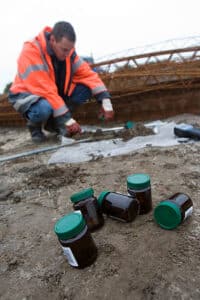Detailed Site Investigations (or Phase 2 ESAs)

Competitive Pricing - High Quality
iEnvi has a network of subcontractors (such as laboratories, drillers, service locators, excavators) who are evaluated and reviewed and ranked in quality, which means we will provide competitive pricing but also high quality in the investigations we complete.
Our DSIs include review and advice from our Principal Environmental Scientists and Certified Environmental Practitioners Site Contamination Specialists (CEnvP CS Specialists), which are often required by financial institutions and government bodies to sign off on investigations.
A detailed site investigation (DSI) or Phase 2 Environmental Site Assessment often follows a PSI (or Phase 1 ESA). Investigations help determine the risk of any ground or water contamination to environmental and human receptors, and of contamination leaving a property and potentially affecting another property (and causing a liability and/or risk to other asset owners).
The level of quality in deciding where to place samples, how many samples to get, and the methods of collecting samples is critical to relying on data.
Developing a sampling and analysis quality plan (SAQP) is the first step, which involves a review of the purpose, methodologies, logic, and quality controls requirements to rely on data retrieved in the DSI.
After sampling is completed and sample analytical results are received from NATA accredited laboratories, the data is reviewed in context to the site and surrounds, and environmental guidelines.
Knowing what relevant guideline criteria are based on or derived from, and how they can be used in the context of each site is critical in understanding the risk and next course of action. There may be duties to report contamination to regulators or to further investigation contamination. iEnvi will always communicate this with our clients and help with a business friendly strategy that is compliance.
The end (and critical) goal of a DSI is to build a conceptual site model (CSM) to evaluate the contamination sources, pathways and any potential receptors, to help visualise the uncertainty of the delineation of contamination and to help evaluate the risk of any contamination to receptors.
If this is not done properly or with high enough quality, then the argument against Tier 1 conservative criteria may be insufficient, or that key aspects were missed that may cause complications later, after commercial decisions have been made such as the purchase or sale of a property or business.
Quick Enquiry
Some of the organisations our expert team have helped






